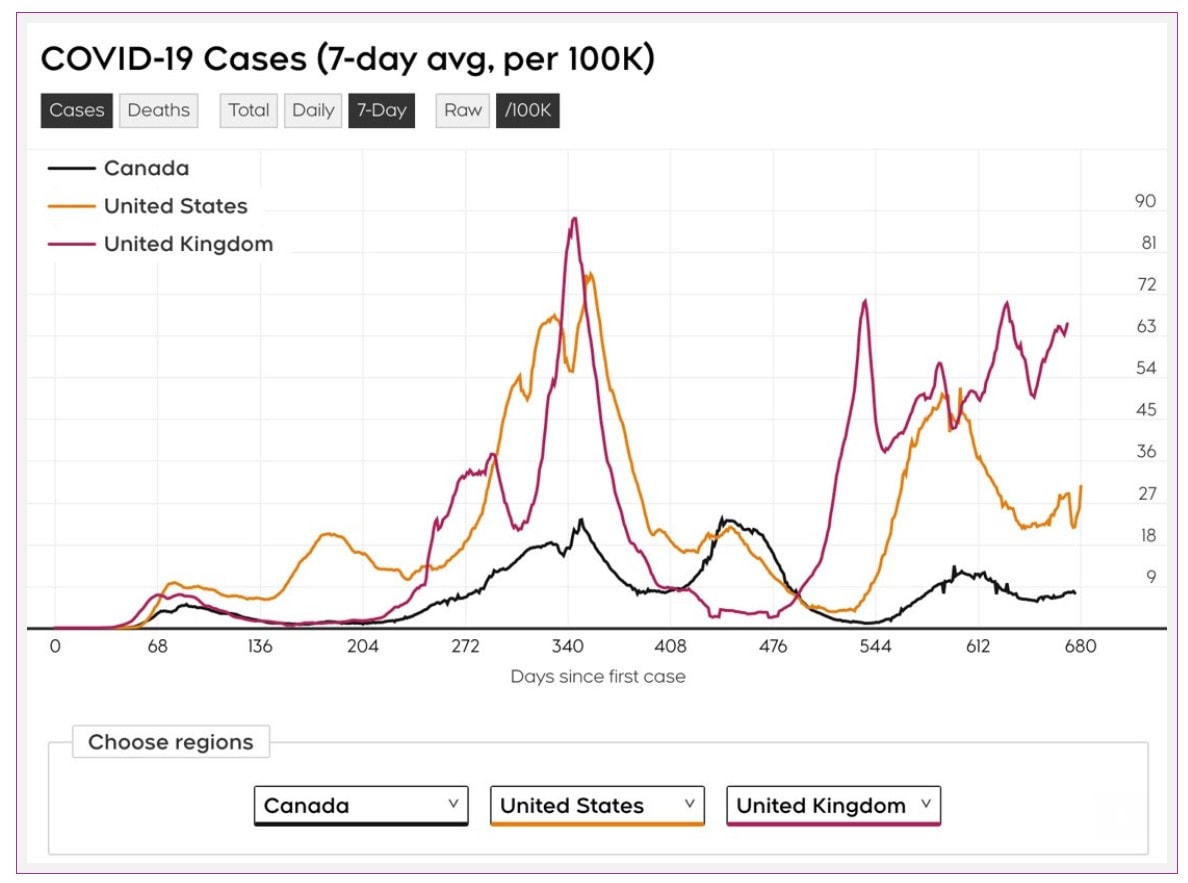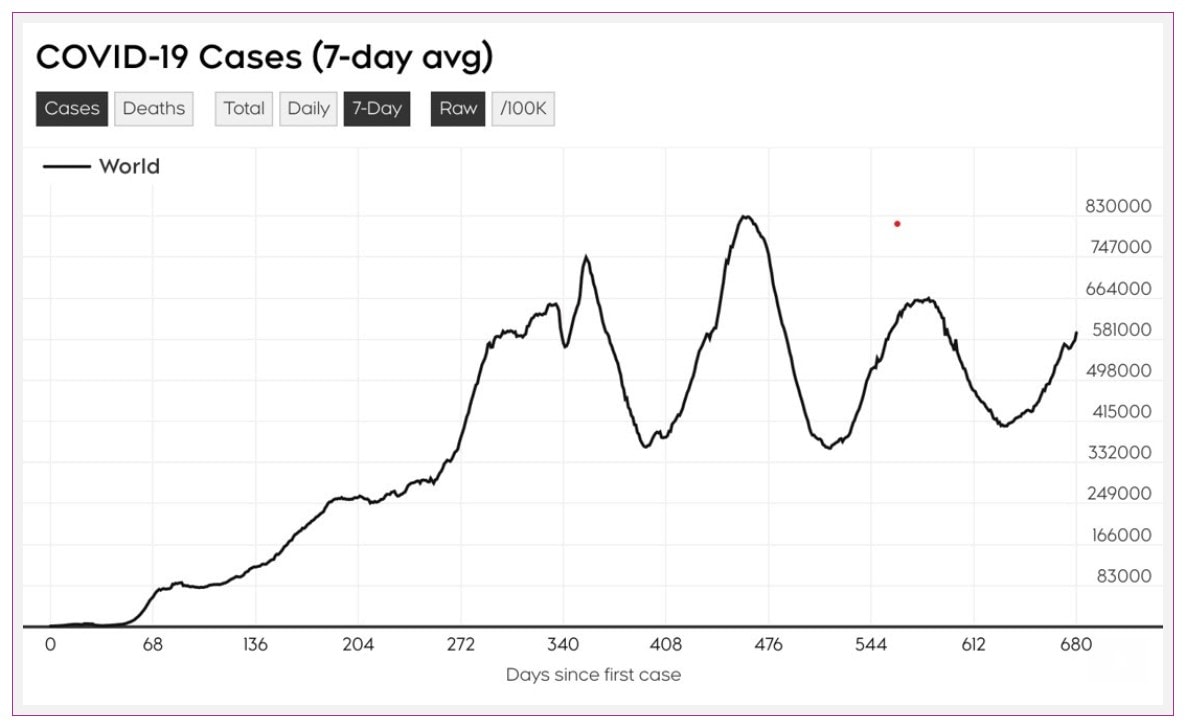Hello friends!
I hope you had a wonderful week.
As we do each week, let’s review the bad news, the good news, your most common questions of the week and my silver lining.
What is the bad news?
Over 263 MILLION cases of COVID have been reported worldwide, with over 5.2 MILLION deaths. This is likely a gross underestimate.
Canada has reported almost 1.8 MILLION cases of COVID-19, with nearly 30,000 deaths.
Cases continue to rise across Canada, particularly in Ontario and Quebec. Ontario had more than 700 new infections a day most days in the last week, with an average of 821 a day. We also reached 10,000 deaths from COVID-19 in Ontario last week.
In Quebec, there are over 1,200 news cases a day. There has been a rise in hospitalizations as well. Provincial data shows that unvaccinated people are greater than 16X more likely to be hospitalized and 3.6X more likely to be infected than vaccinated people.


Starting last week, unvaccinated individuals over the age of 12 are no longer allowed to take a plane or train in Canada, regardless of a negative COVID test.
Travellers entering Canada (except the US) will be covid tested at the airport, in addition to testing before leaving. This will likely add significant delays in airports during the holiday season.
Travellers entering the United States will require a COVID-19 test the day before departure.
Dr. Dina, what is the good news?
In Canada, over 70 MILLION doses have been given and 84.5% of people five years and older have received the first dose, and almost 80% are fully vaccinated. This is pretty remarkable. Nearly 3.0 MILLION doses have been given to kids so far.
Worldwide, 8.1 BILLION vaccine doses have been given, representing 55% having received the first dose and 44% fully vaccinated.
Questions of the week
What do we know about the Omicron variant?
We are learning more about this variant of concern every day. We know this strain contains more than 30 mutations in the spike protein, which allows it to bind to human cells and gain entry into the body more efficiently than previous strains. In addition to these new mutations, Omicron also has characteristic changes in the Alpha, Beta, Gamma, and Delta variants that have not been seen in one virus before.
Omicron appears to be more transmissible than previous strains. We are unsure if it causes more severe illness or a higher risk of death. The World Health Organization hopes to have more information in the next few days.
Toronto Public Health is currently investigating three Toronto residents who have tested positive for Omicron. Two individuals recently returned from travel from Nigeria, while another recently returned from Switzerland. Contract tracing is being completed.
It remains essential to isolate and get tested for COVID-19 if you are sick, particularly if you have recently travelled. Asymptomatic family members and household contacts of those who have recently travelled, cold or flu-like symptoms should also be tested.
Getting vaccinated decreases the risk of serious illness, hospitalization, and death. It also helps protect others from getting sick. Please continue to follow public health guidance such as wearing a well-fitted mask, practicing good hand hygiene, maintaining physical distance and staying at home if you are sick.
Omicron cases are being identified worldwide, including in the U.S, South Korea and India. The situation in Germany continues to worsen, as new cases are above 70,000 per day. 13 cases were identified in one Portuguese soccer team. New cases doubled in a single day in South Africa last week.
Can COVID spread to animals?
Viruses have more opportunities to mutate if they infect more people. Each person who is infected is a potential Petrie dish. Therefore, an unvaccinated population increases the risk of mutations, leading to more worrisome variants of concern.
In August, scientists discovered that 30% of their white-tailed deer in the northeastern U.S. had antibodies against COVID. Then, in November, three white-tailed deer were found to be infected with COVID-19 in Canada. This is concerning that there may be ‘animal reservoirs,’ with the potential that the virus could spread to other species and back to humans. Let’s hope not!
Who can get a booster?
Last week, the Ontario government announced that they are accelerating COVID-19 vaccine booster eligibility to anyone over the age of 50 and additional high-risk individuals as of December 13. After the second dose, appointments will be booked for six months (168 days). Beginning in January, Ontario will further expand eligibility for booster doses based on age and risk, with an interval of six to eight months from the second dose.
Who can get the Johnson & Johnson vaccine?
A supply of 2,500 doses of the single-dose Johnson & Johnson COVID-19 vaccine is now available. It can be offered to people 18 years and older who have an allergy or contraindication to mRNA vaccines or at the request of an individual who has not yet been vaccinated. The vaccine is in limited supply and will be preferentially given to people who cannot receive an mRNA vaccine due to medical reasons (versus personal preference). People with medical reasons can discuss with their healthcare provider, and those without contraindications can contact their local public health unit.
What is the timing for COVID vaccination for kids 5-11?
The recommended COVID-19 vaccine dosing interval for kids is at least eight weeks, as stated by the National Advisory Committee on Immunization. There is emerging evidence that longer intervals between the first and second doses result in a more robust and long-lasting immune response, higher vaccine effectiveness and lower risk of myocarditis and pericarditis. The Ontario COVID-19 booking system will allow appointments to be booked at least eight weeks apart.
Can my child receive another vaccine near the COVID vaccine?
Children should not receive another vaccine, including the flu vaccine, 14 days before or after the COVID-19 vaccine. NACI has recommended this as a precautionary approach to prevent incorrect attribution of adverse events following immunization.
The silver lining of the week
When I reflect on the last two years, I am amazed by our scientific progress. The rapid isolation and genetic sequencing of the virus and the unprecedented rapid development of vaccines and anti-viral treatments highlight what a coordinated and collaborative approach can do. Teamwork has saved millions of lives and allows us to live relatively normally again. It is an excellent example for our kids; we are more efficient and successful when we work together toward the same goal. This is an important lesson for all of us.
Have a fabulous week, friends.






![[Dr. Dina News] IMPORTANT UPDATE re. VIRTUAL CARE](https://drdina.ca/wp-content/uploads/2021/01/dr-dina-kulik-kids-and-virtual-care-1a-400x250.jpg)
![[Dr. Dina News] COVID-19 Vaccine for Infants and Young Children.](https://drdina.ca/wp-content/uploads/2021/04/dr-dina-kulik-kids-and-vaccines-400x250.jpg)
![[Dr. Dina News] COVID-19 Vaccine for Infants and Young Children.](https://drdina.ca/wp-content/uploads/2022/04/DRD-1-400x250.jpg)






